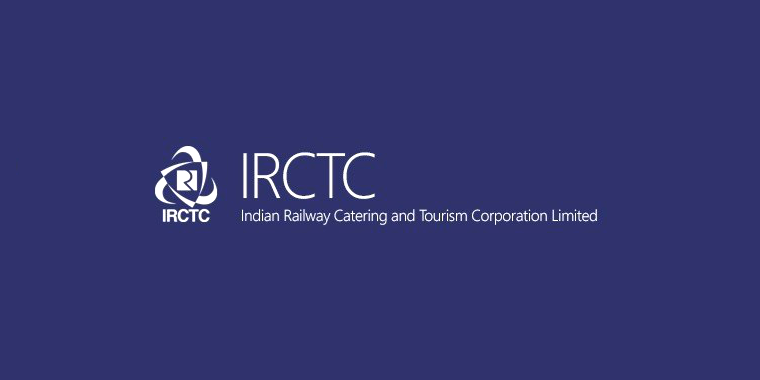New at IRCTC: “Lite” Website, QR Code on e-Tickets
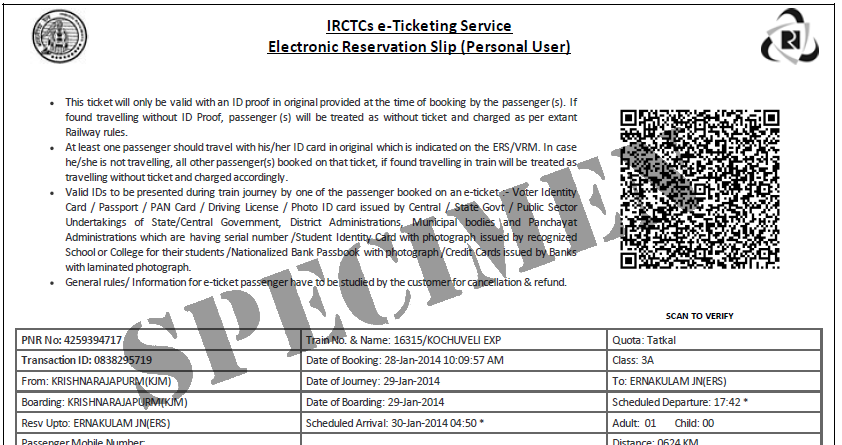
This is an old post. The “lite” IRCTC site does not exist now. To know the latest in the application of technology to Indian Railways ticketing systems, have a look at how to buy Unreserved (General/Second Class) train tickets for everyday travel on your mobile phone using the UTS app.
IRCTC is on a technological roll these days, much unlike the rest of the Indian Railways which seems to be stuck in a stone-age time warp. After being on the receiving end of years of online and offline “love”, they seem to be finally trying to reinvent themselves. Last year they had announced a Rs. 700 crore makeover upgrading their servers and systems to enable booking of 12.5 lakh tickets a minute. It is not known if all that is already in effect, but some more visible changes are already being implemented. Two of those are the IRCTC “Lite” website now seen during high-peak demand Tatkal hours and the second one is the sudden surprising appearance of QR Codes on Indian Railways’ e-tickets issued by IRCTC. Here is the lowdown.
The New IRCTC “Lite” Website
Apparently this is the equivalent of Slim Milk or Diet Coke or frugal Indian versions of cars which when sold abroad are usually fully loaded with goodies. The IRCTC “Lite” or as they unofficially call it, is not a separate website and does not have a different URL (address) or login. It is just our good old irctc.co.in in a “Lightweight” version, stripped of all its unnecessary bells and whistles like pictures, banners, colors etc, populated with only the bare necessary stuff requited to book a ticket. Everything else is the same. According to the time you are trying to access IRCTC, you will automatically get either IRCTC lite or the standard website. IRCTC “Lite” will appear on all mornings from 0930 to 1200 hours during the Tatkal hours and on all other times you will get the standard IRCTC. So, the “Lite” website is served in the morning when the load on IRCTC servers are at their peak with half of the nation scrambling for those prized Tatkal tickets like, well, sorry I can’t find any cliches as all “hard to get” or “unavailability” cliches and jokes are based on Tatkal tickets only. Oh wait! “like guys running after that sole girl in class in engineering college”.
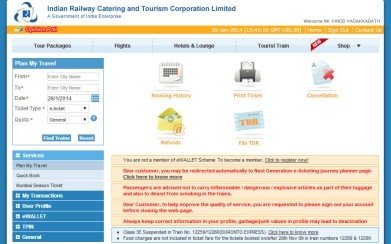
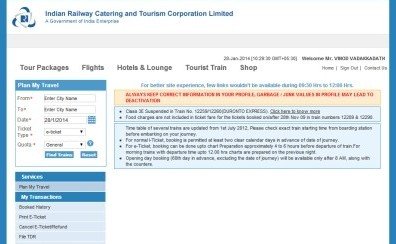
This new IRCTC avatar is their latest attempt to increase site performance during peak hours. This time they are attempting to do so by removing everything that is not a necessity on the website. Gone are all the fancy CSS like shadows, rounded boxes and even horizontal lines, separators and lots of colors, highlights and pictures. Even the “Twisties” on the left sifde menu are missing! Also missing are a lot of links including Registration, e-WALLET, User Profile, Season ticket/Quick Book and all other links which are not necessary. You still can view booking history, cancel tickets and take printout. The resulting product looks bland, bare-bones and anemic but gets the job done. Well almost. For the first time in years I was able to book a confirmed Tatkal ticket online via IRCTC and that too only in 5 minutes and in one attempt, a definite first! I logged in at 1005, got to the payment confirmation page at 1007 and ticket was booked at 1010! To be fair it was an off-season Tuesday, but still this was not possible around a couple of months ago. It remains to be seen how it will perform on Thursdays or Sundays and during holidays.
Indian Railways seems desperate to make ticketing easier for the masses and IRCTC “lite” is again a definite step in the right direction but like I have said before even if IRCTC is given all the computing power in the world nothing is going to change because the real problem is not IRCTC’s speed or capability. The real problem is that there are just not enough trains running and enough seats in them to cater to our huge traveling population. Once this is sorted out, there won’t be any need of a Tatkal system. Being “lite” the site does open faster and you will definitely be able to book tickets faster, but we still have a long way to go for that day to come when people try to open irctc.co.in instead of google.com to check if their internet connection is working.
UPDATE: I tried booking a Tatkal ticket on Friday, Feb 27 on the “IRCTC Lite” version and was predicatably, not successful. Could log in only at 1020 and took 15 min to get to the payment gateway, where it got timed out after payment was deducted. So nothing has changed, everything is as usual.
QR Codes on IRCTC e-tickets
The age-old and perfectly designed layout of IRCTC’s e-tickets have been significantly altered with the sudden appearance of a QR code on the top right-hand corner. No explanation has been provided about the presence of this code other than a “Scan to Verify” text below it. A QR-code is basically a two-dimensional barcode in which anything can be encoded from pictures to text and URLs. When “read” by scanning it using a smartphone camera and any suitable barcode reading app such as NeoReader, the QR code reveals whatever has been encoded in it. QR codes which were cutting-edge tech not so long ago have today become indispensable in today’s “mobilized” world as an easy-to-access medium for access of digital content and any mobile-enabled technology worth its salt today comes empowered with its QR codes. In fact, Airline tickets have long since been coming with QR codes.
Likewise, the QR code on the Indian Railways e-ticket (issued by IRCTC) will contain encoded all details of the ticket and passenger, which will be revealed when scanned: PNR number, Quota, Train number and name, origin and destination of the traveler, departure time and date and class of travel, name of passengers, ticket status and berth/seat number (if confirmed) and the cost of the ticket.


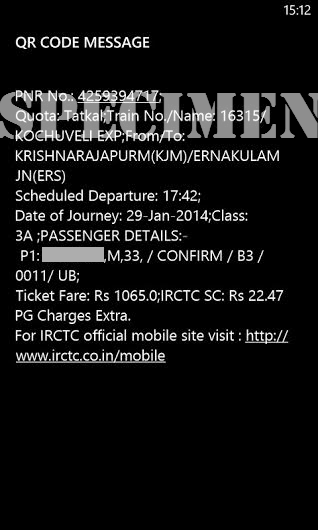
I swear I am not posting these screenshots to brag about my confirmed Tatkal tickets.
All that tech is wonderful an all, but what good will it do to the Railways? I mean, you are scanning the ticket itself, which also has all the info which is just being reproduced on a mobile device. And incorporating a QR code is no rocket science, anyone can do it. So what good is having two copies of the same tickets? And what about the IRCTC SMS which is as good as ticket anyway?
Indian Railways work in ways more mysterious and secretive than the Illuminati and typically of them, they are tight-lipped about this development too. Since IR don’t seem to be revealing anything, the fun part of decoding the entire thing is left to us. So let me speculate. What will this technological innovation do?
To Curb Illegal Ticketing/Touts?
IRCTC has stringent measures in place to discourage illegal ticketing, rogue agents and touts, including not allowing agents to book tickets during Tatkal hours, limiting total booking in a month to 10 tickets from normal accounts, massive drives to identify and disable fraud accounts and even scanning PNRs to “seize” illegal tickets. QR coding might be helpful to identify illegal tickets whose data has been changed (names, dates etc) but since it is just a reproduction, illegal activities at the origin (mass booking) etc is not going to be curbed by this.
Computerization of the Entire Ticketing and Checking System?
Sounds plausible. The weakest link in the entire railway ticketing saga is the one who handles the entire thing on real ground zero, the guy in the black blazer and a clipboard who ticks off lines after lines of names on stacks of dot-matrix printed charts. Imagine if instead of charts, TTEs (not TTRs) come armed with a handheld device which will be linked via GPRS/3G to the CONCERT server which houses the entire chart of the train? Boom! The entire process has been successfully computerized! The TTE can instantaneously find a seat, coach and passenger on the screen of his handheld. And checking tickets will not be easier. The TTE scans the QR code, the system recognizes the passenger as traveling and returns an acknowledgement on the machine. Scan, done. Scan, done. At the end, the TTE can see which seats are not allotted, which seats are no-shows etc and can easily do seat allocations accordingly. The machine can also be used to issue fines and tickets as well, for which it would also have a POS swiping slot and a printer. TDRs will become a thing of the past, as untravelled/railways’ fault s refunds could be processed instantaneously. The possibilities are endless!
Imagine all the tons of paper we will save everyday by doing away with all those charts! Half of India’s forests will be saved. But all this pertains only to e-tickets. What about the lowly PRS tickets? They are still being printed using dot-matrix printers on which ordinary text is hardly readable, forget QR codes. I am sure Indian Railways is as of now the World’s largest user of dot-matrix printers. Well, all printers in all PRS counters will have to be replaced by Inkjet printers so that they can print barcodes. (Hopefully this will not result in another scam) With this done, dot-matrix printers can finally become extinct and die in peace.
As an eternal pessimist I wouldn’t want to hope too much here but are these QR codes the beginning of the bigger plan of the eventual end-to-end computerization of the Indian Railways ticketing system? Only time will tell.
Emergency Quota: Something I am really pissed at IRCTC is for withdrawing the “Shubh Yatra Frequent Travelers'” scheme. I had some 2700 points stuck there and have missed out on quote some after as well. Hope they reinstate the program and the points 🙁




